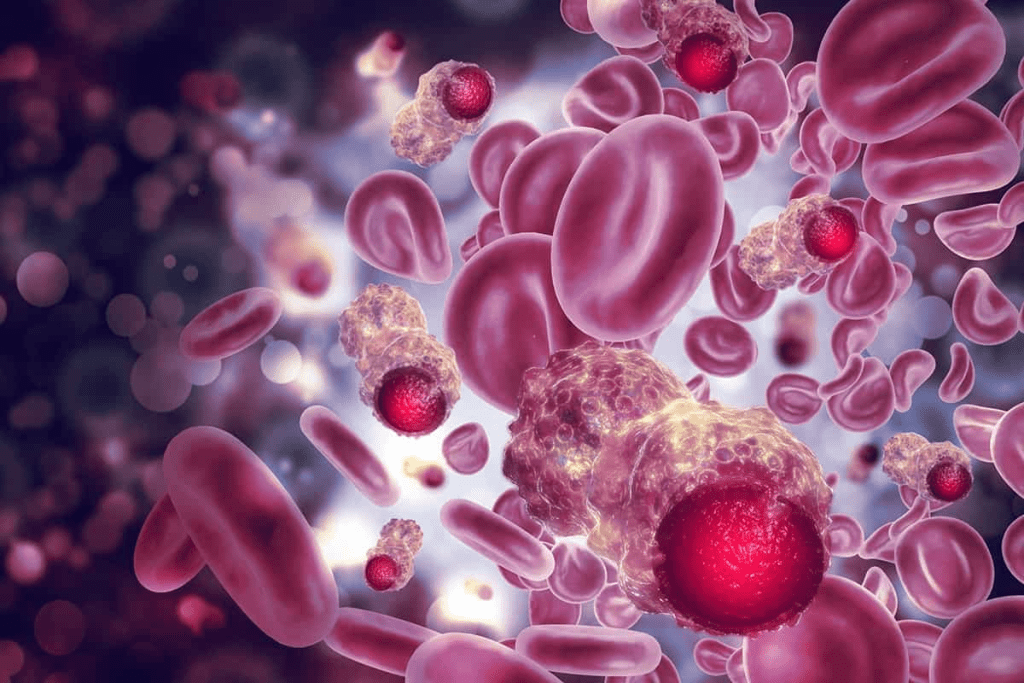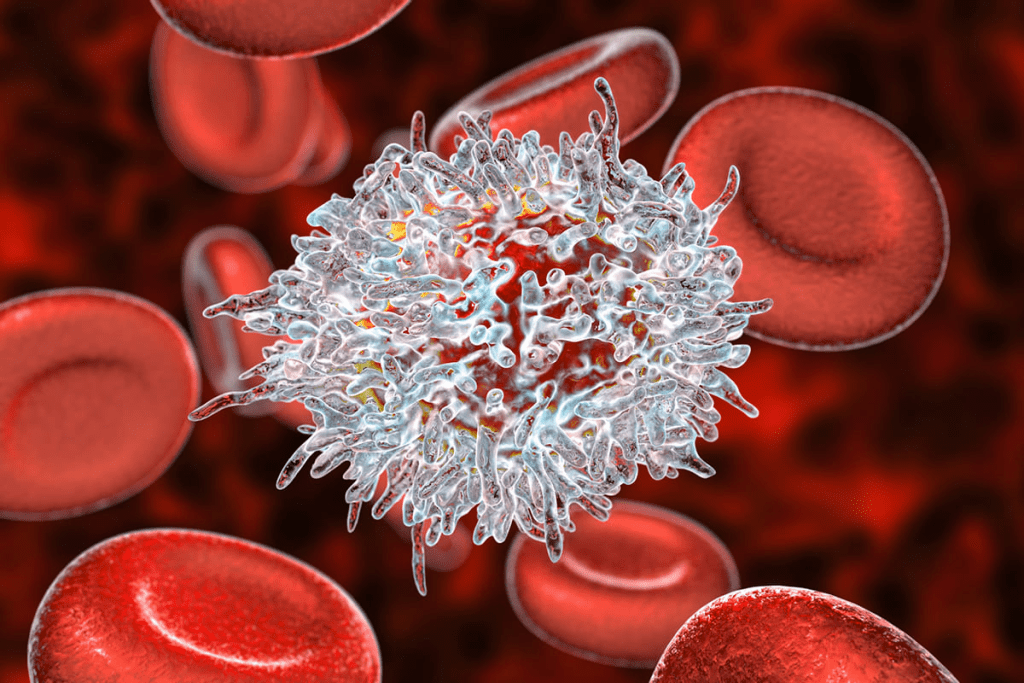Last Updated on November 13, 2025 by
The complex connection between low platelet count and blood cancer is explained, clarifying the thrombocytopenia leukemia relationship in diagnosis.
Thrombocytopenia is when you have too few platelets. It often happens with leukemia. We look into how these two are connected and what it means for patients.
The Canadian Cancer Society says thrombocytopenia can come from leukemia or chemotherapy. Research shows that about 28% of people with blood cancers, like leukemia, get thrombocytopenia.

We dive into how leukemia can cause low platelet counts. We also talk about how this affects treatment choices and how patients do.
It’s important to know about thrombocytopenia to help patients with blood disorders. This condition means you have too few platelets. This can cause serious health problems.
Platelet counts should be between 150,000 and 450,000 per microliter of blood. Platelets help blood clot, and not enough can make bleeding more likely. Keeping platelet counts in the normal range is key for staying healthy.

Having fewer than 150,000 platelets per microliter is a sign of thrombocytopenia. This can happen due to many reasons, like bone marrow problems or leukemia. It’s important to catch and treat this early to avoid bleeding risks.
Signs of thrombocytopenia include easy bruising, small spots on the skin, and bleeding gums. Severe cases can cause serious bleeding. Spotting these signs early can help prevent bigger problems.
Understanding thrombocytopenia helps doctors give better care to patients with blood cancers or leukemia.
Leukemia is a cancer that affects the blood and bone marrow. It causes an abnormal increase in white blood cells. The bone marrow, found in bones like the hips and thighbones, makes blood cells.

Leukemia is divided into acute and chronic types. Acute leukemia has immature blood cells that don’t work properly. Chronic leukemia has more mature cells that can function a bit, but it’s slower.
Leukemia is also split into myeloid and lymphocytic types. Myeloid leukemia affects cells that make red blood cells, platelets, and some white blood cells. Lymphocytic leukemia impacts cells key to the immune system.
Leukemia can fill the bone marrow, stopping normal blood cell production. This can lower the number of platelets, causing thrombocytopenia. Thrombocytopenia means not enough platelets, raising the chance of bleeding. This is a big problem in leukemia.
Research shows that thrombocytopenia is more common in patients with leukemia than in those with solid tumours. This section looks at the evidence linking thrombocytopenia and leukemia. It includes data on how often it happens and how it compares to solid tumours.
Studies have found that thrombocytopenia is a big problem for leukemia patients. A study in the Journal of Clinical Oncology found that up to 70% of leukemia patients get thrombocytopenia during treatment. This shows how important it is to manage thrombocytopenia in leukemia.
Thrombocytopenia is more common in leukemia than in solid tumours. Hematologic malignancies affect the bone marrow and lymphatic system, which are key to blood cell production. Solid tumours can cause problems if they spread to the bone marrow, but it’s less common.
The severity of thrombocytopenia varies with different types of leukemia. For example:
Knowing these patterns is key to effectively managing thrombocytopenia in leukemia patients.
It’s important to know how leukemia causes low platelet counts. This condition comes from several factors working together.
Leukemic cells invade the bone marrow. This messes up the bone marrow’s job of making platelets. The cells take over, leaving less room for platelet-making cells.
Megakaryocytes, key in making platelets, don’t work well in leukemia. The bone marrow changes because of leukemia cells. This affects the growth factors needed for megakaryocytes.
This makes the platelet count even lower, worsening thrombocytopenia.
Platelets are also destroyed outside the bone marrow. Leukemic cells can trigger the immune system to attack platelets. Some leukemia types cause the spleen to grow, trapping and destroying platelets.
Experts say, “The destruction of platelets outside the bone marrow is a big part of thrombocytopenia in leukemia patients.”
“Thrombocytopenia in leukemia is not just a matter of reduced production; it’s also about increased destruction.”
Knowing how leukemia affects platelets helps doctors manage this issue better. By tackling both production and destruction, they can improve patient care.
Chemotherapy is key in treating leukemia, but can lead to thrombocytopenia. We look at how it impacts platelet production, the timeline of this effect, and risk factors for severe drops in platelets.
Chemotherapy drugs can slow down bone marrow, reducing platelet production. Common chemotherapeutic agents that affect platelet counts include:
These drugs can harm the bone marrow’s ability to make platelets, causing thrombocytopenia.
The time it takes for thrombocytopenia to occur after chemotherapy varies. It usually starts 7-10 days after treatment begins. It can take weeks for platelet counts to go back up.
Some factors can make leukemia patients more likely to have severe thrombocytopenia. These include:
Knowing these risk factors can help manage and lessen the severity of thrombocytopenia caused by chemotherapy.
Thrombocytopenia makes treating leukemia harder, affecting patients in many ways. It’s not just a side effect but a key factor in treatment and care.
Thrombocytopenia raises the risk of bleeding in leukemia patients. Bleeding can be minor or life-threatening. We use tools and scoring systems to assess this risk.
Accurate assessment is key for managing thrombocytopenia. It helps us decide on preventive measures and watch for bleeding signs.
Thrombocytopenia often means changing leukemia treatment plans. Chemotherapy may be adjusted or delayed to avoid severe thrombocytopenia. We aim to manage leukemia effectively while minimizing risks.
Thrombocytopenia also affects the choice of treatments. Some treatments are more likely to cause thrombocytopenia. We look for alternatives to avoid this.
Thrombocytopenia can greatly affect a patient’s quality of life. Even simple activities can be risky due to bleeding fears. We help patients find ways to stay active and safe.
Severe thrombocytopenia increases the risk of death in leukemia patients. Life-threatening bleeding can occur. We stress the need for close monitoring and proactive management.
“The management of thrombocytopenia is a critical component of leukemia care, directly influencing patient outcomes and quality of life.”
In conclusion, managing thrombocytopenia in leukemia is complex. Understanding the risks and using the right strategies can improve patient outcomes and quality of life.
Managing leukemia patients with low platelet counts is complex. It involves many steps to reduce bleeding risks and improve treatment results. Each patient’s needs are unique, so care must be tailored to them.
Platelet transfusions are key for patients with low platelet counts, like those with leukemia. They are given during intense chemotherapy or when counts drop too low. The decision to transfuse depends on the patient’s health, platelet count, and bleeding risks.
Thrombopoietin receptor agonists (TPO-RAs) boost platelet production. They work like the natural hormone thrombopoietin. These drugs are promising for managing low platelet counts caused by chemotherapy.
TPO-RAs may cut down the need for platelet transfusions. This could allow for stronger chemotherapy. But their use must be weighed carefully for each patient.
Supportive care is also critical for managing low platelet counts in leukemia patients. This includes:
By using these strategies, healthcare providers can help leukemia patients with low platelet counts. This approach reduces bleeding risks and improves treatment results.
Managing thrombocytopenia in leukemia patients needs a team effort. We use many strategies to help. Thrombocytopenia is a big problem in leukemia treatment, affecting patients’ lives and health.
We take a proactive approach to tackle low platelet counts. This means treating thrombocytopenia and preventing it from happening. We want to lessen its impact.
Acting fast is key in managing thrombocytopenia. We find patients at risk and start treatment early. This might include changing their chemotherapy, using special drugs, or giving platelet transfusions.
“Early action can greatly lower bleeding risks and better patient results.” We watch platelet counts closely and act quickly. This helps prevent severe thrombocytopenia.
Using global research is important for leukemia care. We keep up with new studies and use them in our treatment plans. This way, our patients get the best care possible.
A team effort is essential for managing thrombocytopenia in leukemia. Our teams include doctors, nurses, and others. They work together to create detailed care plans.
“A team-based approach ensures that all aspects of a patient’s care are considered, from the management of thrombocytopenia to the psychological support of the patient.”
Together, we offer complete care that meets all our patients’ needs. This improves their experience and results.
It’s key to watch platelet counts closely when treating leukemia. This helps doctors see if a patient is at risk for bleeding. It also shows how well the treatment is working.
Looking at how platelet counts change over time is more helpful than just one number. It shows how a patient is doing with treatment and any risks they might face. This way, doctors can spot early signs of problems and act fast.
A study on thrombocytopenia and bleeding in myelodysplastic syndromes shows why it’s so important to keep an eye on platelet counts in patients with blood cancers.
How platelets bounce back after treatment can tell a lot about a patient’s health. Quick recovery often means treatment is working well. But slow or no recovery might mean there are bigger issues.
Key factors to consider include:
New tech makes it easier and more accurate to track platelet counts. Machines and devices that can check counts right away are super helpful for patients with leukemia.
New studies are looking into more than just how many platelets there are. They’re checking how well platelets work together. This gives a clearer picture of a patient’s blood health.
Future directions might include using smart tech to predict how patients will do based on lots of data.
Thrombocytopenia is a big problem for leukemia patients. It can happen because of chemotherapy or the disease itself. We need to manage it well to avoid bleeding and keep treatment going.
New ways to handle thrombocytopenia, like platelet transfusions and special medicines, have helped a lot. We should keep working to make care better and improve the quality for these patients.
Using research from around the world and working together as a team can help a lot. It’s also important to watch how platelets change during treatment. This helps us make the right changes to treatment plans early on.
We aim to give top-notch healthcare with full support for patients from everywhere. This way, we can really help those dealing with leukemia and thrombocytopenia.
Thrombocytopenia is when you have too few platelets in your blood, usually less than 150,000/mcL. It often happens in people with blood cancers like leukemia. Up to 28% of these patients get it.
Symptoms include bruising, small spots on the skin, and bleeding gums. These can really lower a person’s quality of life.
Leukemia can fill up the bone marrow, stopping it from making normal blood cells. This includes platelets. It makes it hard for the body to make enough platelets and can destroy them, too.
Yes, chemotherapy can cause low platelet counts in leukemia patients. Some drugs used in treatment can harm platelet production.
Thrombocytopenia can lead to more bleeding, changes in treatment plans, and a lower quality of life. It can also increase the risk of death.
Doctors use platelet transfusions, special drugs, and supportive care to manage it. These steps help reduce risks and improve patient outcomes.
Early action, using global research, and teamwork are key. They help manage thrombocytopenia well.
Keeping an eye on platelet counts is vital. It helps predict bleeding risks and guide treatment. New technologies can make monitoring better.
These drugs help make more platelets. They reduce the risks of low platelet counts in leukemia patients.
Different leukemia types can cause different levels of low platelet counts. Some types are more likely to cause severe drops.
Factors include the type and strength of chemotherapy, patient health, and the leukemia type itself.
Subscribe to our e-newsletter to stay informed about the latest innovations in the world of health and exclusive offers!